My name is Danny. I like to play games that never got a chance in the west and writing about them.
Don't wanna be here? Send us removal request.
Text
#19: 最後の約束の物語/Saigo no Yakusoku no Monogatari
The end is upon us. Endless waves of heartless machines strike at the castle walls in the besieged kingdom of Yggdra. Knowing nothing of the nature of their enemies, a small group of knights attempt to rescue as many of their fellow citizens as they possibly can against impossible odds. You play as Wolf, the group’s newly appointed leader. The castle falls in 24 hours. Welcome to the bright and cheery world of Saigo no Yakusoku no Monogatari! No pressure!

Released by now-defunct developer Imageepoch in 2011, SYM is one of the darkest RPGs I've ever had the pleasure to play. The game is dripping with a pounding sense of urgency and lurking horror, and features plenty of twists that had me genuinely disturbed. SYM is not afraid to kill off important characters, depict the worst of humanity, and, worst of all, features a harsh time limit: in this game, each quest completed advances an in-game clock which acts as a trigger to move the plot forward. The quests are similar to those you would find in an MMORPG: you're typically asked to go out into the ruined castle and rescue stranded citizens, and these usually end in a challenging encounter with a mechanized monstrosity.

And SYM’s combat is intense. As you progress through each chapter, the enemies you’ll contend with keep their pace with your party, meaning that you cannot rest on your laurels and mash the X button. You'll be buffing, debuffing, hitting elemental weaknesses, and managing a "hate" system, which is a feature found (again) in MMORPGs. Certain actions, such as healing and using AOE spells, will draw the ire of the enemy group, which can be deadly. Only the main character possesses abilities that can draw hate, so you'll be heavily reliant on him to manipulate the flow of battle. Thankfully, SYM gives him a variety of options to do so: one skill will have him act before the rest of the party, while another will activate after everyone's taken their turn. It's up to you to utilize him well, because if you don't, well..Welcome to the SP system!

Your party members have your normal HP and MP gauges, but each character, a bit like the Romancing SaGa series, has a separate stat called "Spirit Points." Each character starts off with a predetermined amount, and every time they're knocked out, they lose a handful of SP. The caveat is that there is only one way to restore SP, and once it is gone, they're dead. Forever. SYM is one of the few character-driven JRPGs to feature permadeath. You might think that, should a character be knocked out, the enemies will then turn their attention on your remaining members, but this is not the case. Your foes will relentlessly beat on your fallen comrade, knocking down their SP even further. In one disastrous battle early-game, my favorite character, Mallarme, lost nearly 20 SP in one go. Ouch.

You might be thinking, "But Danny! You said there's a way to restore SP! It can't be that bad!" but nah: in order to restore SP to a party member, another has to die. SYM's story is heavy on themes of sacrifice and carrying on despite inevitable odds, and I think it is a stroke of brilliance that Imageepoch managed to marry its story themes with gameplay. If you want everyone to survive, you're going to have to carefully switch characters out, all the while considering each member's strengths and weaknesses. Make the wrong choice, and they will die.

And the game doesn't make it easy: there's a slight experience modifier to help underleveled allies, but characters still level separately, making keeping everyone up to speed a chore. Every knight has a variety of skills, with some more specialized than others, but they're all pretty viable with the exception of Celes. I could not figure how to use her effectively: her magic attacks barely do any damage, and her buffing skills all come with certain drawbacks - mainly: they draw huge amounts of hate. Plus, should she or Wolf die for good, it's game over.

Each Messiah Knight also has access to certain techniques that consume SP instead of MP. These are essentially win buttons, doing massive amounts of damage, and have cool portrait cut-ins similar to all-out attacks in the Persona series. Theoretically, should you have trouble with the bosses, you could just spam these with characters you don't care about, but it is much more satisfying to win with the other tools the game provides you.

Personally, I chose to not use my favorite characters, and went with a “B Squad” of sorts for the majority of the game. It feels like SYM almost discourages you from using your favorites, as any mishap in battle can potentially cost you a great deal of SP damage. My plan was to push the “B Squad” characters to the grave, so that I could then finish the game with my favorites later. It felt cruel. I loved it.

Certain quests allow you to grow closer to the character of your choice, but these skits are disappointingly short and, as of this writing, shallow. In fact, the entire game could have used more fat in the story department. SYM has such an unique setting and atmosphere. You're not travelling the world or trying to kill God: you're a knight trapped in a ruined castle trying to save his people. I think RPGs that take on a more limited scope have a lot more opportunity to really breathe life into their settings, but SYM doesn't succeed in doing so.

The level designs are repetitive: with few exceptions, you'll spend the majority of the game traversing hallways peppered with the occasional treasure chest. If you're familiar with Persona 3, this shouldn't bother you too much, and I didn't mind it as a fan of Tartarus, but those looking for a more streamlined experience should look elsewhere. Enemy design is well-done, but I would have liked a bit more variety. There are a lot of palette swaps. In contrast, the end-of-chapter bosses are terrifying and super badass.

Overall, the themes presented in SYM are done much better in later Imageepoch titles, such as 7th Dragon: 2020, but the unique, desperate atmosphere present in this title makes it worth checking out. The game can be unbearably tedious at times, but unlike many JRPGS, SYM maintains a level of tension that never leaves the player. The constant threat of death and unrelenting melodrama makes it stand out amongst its peers. If Imageepoch’s budget for this title was just a little bigger, it could have been truly great, but its limitations hold it back. That being said, SYM does enough right that its still very much worth playing!
#gaymer#imageepoch#saigo no yakusoku no monogatari#jrpg#gaming#psp#retro gaming#retro game#game review
5 notes
·
View notes
Text
#18: ユーディーのアトリエ / Atelier Judie
I've always been curious about the Atelier series - created by developer Gust, there are over 20+ games as of 2021, and judging from what I've read online, it's very popular both here and in Japan. Later entries in the series are localized nowadays, but the first few games have yet to see any kind of English release, so I decided, pretty much at random, to start with Atelier Judie. I considered starting from the beginning with Atelier Marie, but I screwed up my PS1 emulator settings somehow, and the thought of redoing everything made my spirit hurt.

True to its title, you play as a young alchemist named Judie, who lives in the outskirts of Life village. She makes a living doing odd jobs for the townspeople and the occasional adventurer. One day, a stranger asks Judie to create a magical McGuffin that can temporarily stop time. This task turns out to be a tad beyond her alchemical skills, and our unfortunate protagonist is sent 200 years into the past.
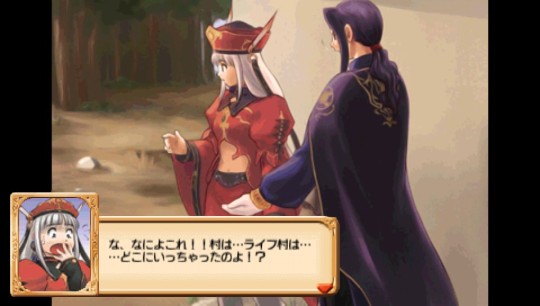
She takes it well-enough, despite losing literally everything and everyone she cared about - and takes up residence in the town Verun, where she once again begins to work as a freelance alchemist in order to pay her benefactor, the loan shark Vitoss, and to find a way back to get back home. Along the way, you'll explore the land of Gramnad, meet all sorts of charming characters, and craft. Lots and lots of craft. Ing.
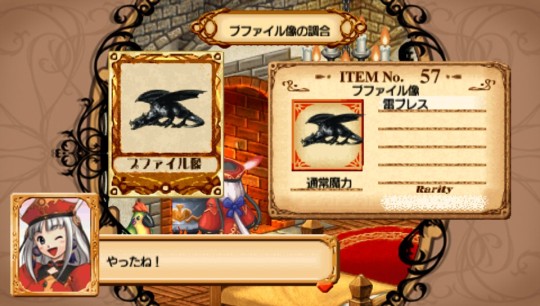
In order to actually make anything, you'll need to go foraging for ingredients - each town has its own wild area to explore, and what you'll find is naturally different in each one. Judie is a bit weak at the beginning, however, so you'll be relying on hirable adventurers to do the majority of the combat. Their help doesn't come free, but I rarely had any issues with keeping a party for the majority of the game.
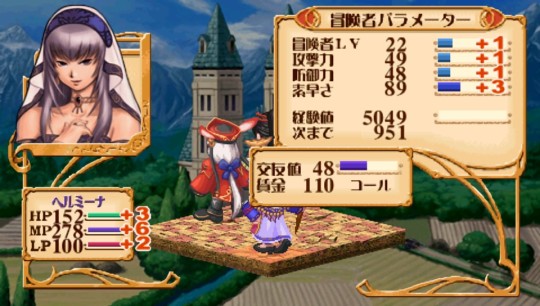
The combat itself is standard JRPG fare, albeit with a few twists. Instead of the usual MP and HP stats, there's an additional LP (Life Point) stat that is used for combat techniques, not magic. Interestingly, whenever any of these stats hit 0, that character will be unable to battle. This also applies to monsters. Certain enemies, usually the undead, will use attacks that drain LP and / or MP, so they present a unique threat to your more tankier party members, as they usually have dangerously low MP values.
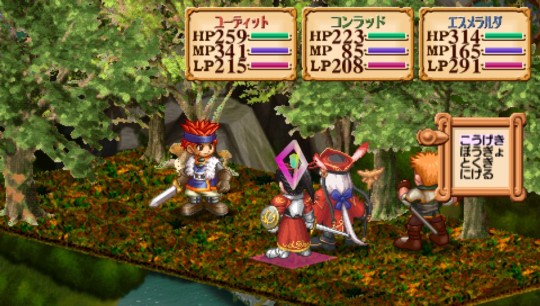
Furthermore, only alchemists are able to use items in battle. This can make battles a bit tense, as you have to solely rely on Judie for healing. There is another alchemist you can recruit, but in my experience, this made for a unbalanced party, unless you craft an absolutely insane amount of bombs in order to make up for the lack of melee prowess. Each character has their own special skills and abilities, with very little overlap - from what I’ve seen, only Christa and Vitoss share a technique. This makes each character feel special, even if most only get, at most, 3 or 4 at higher levels. I would have liked a few more, but this is an open-world game from 2002. Yeah.
The real meat of the game, of course, is in the crafting. You'll find recipes for items through books bought from stores, and occasionally through events. Once you find the required ingredients, you'll select your desired item from a menu, and then hope for the best. Each item has its own difficulty rating, and your rate of success will rise as your alchemy level increases through repeated crafting. Be aware that crafting takes LP and in-game time, so if you're at risk of missing deadlines, you'd do well to finish any previous commitments before going on a spree.

Depending on the quality of the ingredients used, you can increase, for example, the amount of HP a healing item restores, or even change what the item does entirely. There's an item you'll be making early on that, in theory, decreases the amount of enemy encounters on the world map once its equipped. However, if you tweak the recipe a bit, you can make a different version that actually increases it, or even influence what kind of monsters you encounter. Discovering these alternate effects is a lot of fun, and I spent an enormous amount of time unconcerned with the plot just playing around and experimenting.
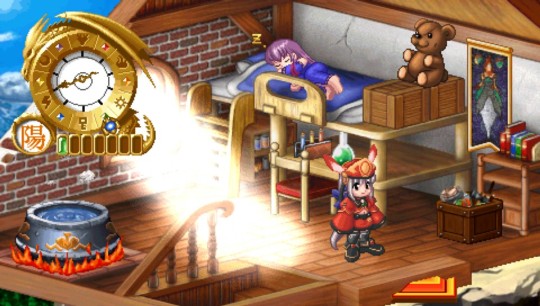
You also have to be mindful of the self-life of ingredients. As time passes, many items will decrease in quality, though this is mainly an issue for organic products. I was quite surprised the first time I went on a real dungeon dive - I had prepared a few bowls of cream soup, an HP healing item, just in case I needed them. Unfortunately, they spoiled halfway through the trip, so I was shook when I accidentally poisoned my entire party instead of healing them! Thankfully, should your entire party get knocked out, you're sent back home with the only penalty being a loss of time.
Speaking of home, one of my favorite aspects of Atelier Judie is the ability to move your base of operations to one of several locations - each one has its own advantages and disadvantages. For example, in one town, you'll have easy access to fruits and vegetables, eventually being able to plant them yourself. In another, you'll have access to a freezer, allowing you to preserve delicate ingredients. My favorite town and current base is in Prostark. Here, you're only a few steps away from a smelting furnace and a mine - many of the mid-game items require ingots, so it's a great fit. The downside to Prostark is that I'm quite a bit away from nature. When I need vegetables or herbs, I have to run the risk of them rotting before I even get home. This risk is further exacerbated due to Atelier Judie’s random event system. These can be harmful or beneficial, but most of the time, they'll either improve or decrease ingredient quality. It's a surprising element of realism that I found fresh. Pun intended.

In fact, there is a lot of randomness present in Judie. Plot-advancing events seem to happen seemingly at random: I'd spend days feeling like I wasn't getting anywhere, only to be suddenly blindsided with access to new areas or characters to meet. I was often left feeling lost, as I could not discover any kind of pattern as to what unlocks what, but in general, it's best to change up your party members and move bases every now and then. The game also features random vignettes that allow you to get a better sense of who your party members are as people. These are usually comedic, and are always accompanied with beautiful artwork.
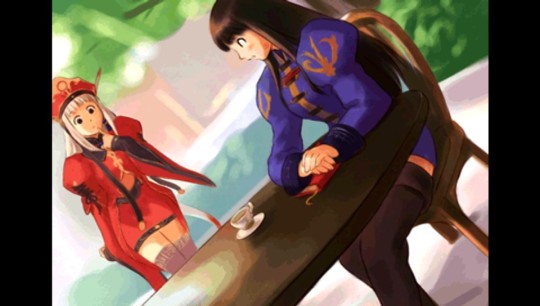
I love the warmth present in Atelier Judie. As a whole, it's simply a delight to play. The encounter rate can grate a little, and tracking down ingredients can get a bit tedious - especially so with items with low spawn rates - but overall, it feels like a lot like a fairytale. The art-style is bright and charming, even the monsters are adorable (my favorite being the Ghost family) and the land of Gramnad feels alive and bursting with character. There's an astonishing attention to detail. I enjoyed how every town's bartender, merchant, etc, had their own unique voice actor and personality. Subjectively speaking, the game just feels like it was made with love. And that's incredible.
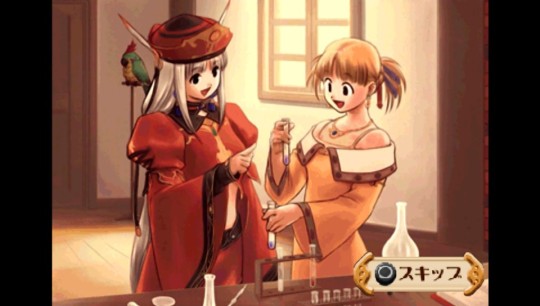
Highly recommended!
15 notes
·
View notes
Text
#17: セブンスドラゴン2020 / 7th Dragon: 2020
The year is 2020. The world is under siege by murder hornets, political unrest, a pandemic, and swarms of ferocious dragons. The fact that only one of the above is fake speaks to how much of a dumpster fire this year has been. Personally, as an "essential worker" who runs a coffee kiosk, some of the behavior that I have witnessed with regards to masks and general safety has taken what little faith I had in humanity and ground it into dust. I have been gaming - and drinking - much more than I ever used to, and while it has saved me money in the long run, I sometimes feel guilty with how much I've dove into this hobby. But who cares, really?
I discovered 7th Dragon 2020 through a random late-night Google search: I occasionally dig around the Japanese side of the internet for research on what games I'd like to play next, and the moment I realized that this game was set in post-apocalyptic Tokyo, in the year 2020, I knew I had to play the absolute hell out of it, regardless of quality.
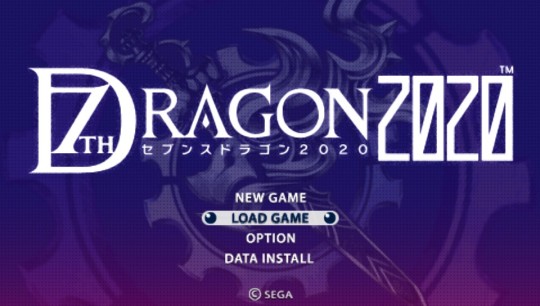
Art imitating life? We love to see it!
As stated above, 7th Dragon takes place in Tokyo, Japan. You begin by creating your main character, choosing a class and appearance. What really surprised me, however, was the sheer amount of voices you can choose from - I'm not really an anime fan, but according to the game's official website, quite a few famous voice actors lent their talent to the game, and they're all full of personality. Want to make a foul-mouthed gothic lolita? You can. A beefcake with the voice of a 10 year old? You can do that too.
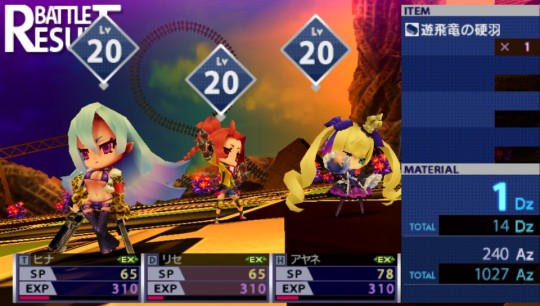
The game features 5 different classes to choose from: Samurai, Destroyer, Psychic, Hacker, and Trickster. Out of these five, I decided to make my main character a Trickster - all classes in 7th Dragon are essentially a sort-of "two-in-one" deal, and in the Trickster's case, their skills are divided between gun and dagger skills, and they both do very different things. Daggers tend to focus more on applying various debuffs to enemies - such as poison, silence, and so forth, while with guns, you'll be avoiding enemy attacks, employing counters, and inducing critical attacks. With the proper set-up, gun Tricksters can then apply constant damage with a possibility of avoiding enemies entirely. To round out the party of three, I then chose to make a Hacker and Destroyer.
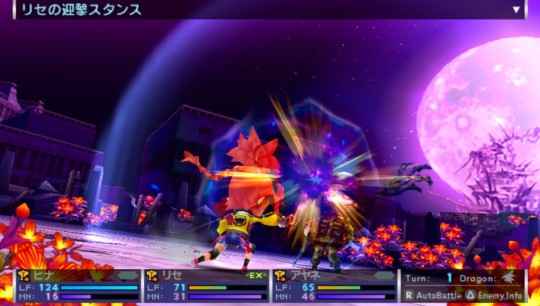
Destroyers are your main brawler class, but with an interesting twist. Their abilities all revolve around applying what is called a D-Counter to enemies - certain attacks increase this value, and you can only perform the more devastating attacks once you raise this to the appropriate level. D-Counters wear off over time, too, so it is important for this class to keep up offensive pressure in order to be effective.
Alternatively, you can develop them to become more of a tank: Destroyers possess a stance that draws enemy attention. Once attacked, they'll respond with a powerful counter - this is obviously a great way to protect your squishier party members, and it is extremely satisfying when you successfully bait enemies into destruction. Later on, you'll learn more specialized counters that will allow you to ignore enemy damage entirely, but there's a catch: you have to predict what type of attack they'll use - will they try and bite you, use their claws, or cast a spell? You'll have to pay attention to not only monster anatomy, but to attack patterns, too.
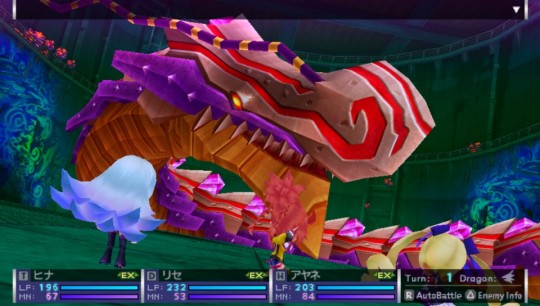
Hackers are the main support class in 7th Dragon: they have the bog-standard buffing spells, but I have to give special recognition to the developers of 7th Dragon for going out of their way to come up with some unique abilities that I have yet to see in any other game. For example, Hackers can set-up a "safety net" that will automatically revive fallen party members at the end of a round, but it is required to be casted at the beginning of that turn. Know a boss is about to end you with their strongest attack? Cast it and hope for the best. They can also decrease the amount of turns your party suffers from status effects, and even increase the rate at which your auto-skills activate.

They can, true to their name, also "hack" into enemies. I haven't played with these skills as of this writing, but it involves the Hacker inducing a status effect of the same name, and then causing all sorts of shenanigans. Other classes possess abilities that can make enemies weak to hacking, which reduces the amount of set-up required. In my case, I decided to focus on the support abilities due to the gaps in my party's defenses, but I can easily see how a more offense-focused Hacker can be a huge asset in battle.

As stated earlier, 7th Dragon 2020 takes place in Tokyo after a sudden and cataclysmic invasion by hordes of enigmatic dragons. Their ultimate objective is unknown, as they do not speak or interact in any manner that is not hostile. You play as a member of the government organization Murakumo, lead by an alarmingly busty woman known as Natsume. Determined to take back the country, you are then sent out into various Tokyo neighborhoods, warped by the dragon's magic, in order to discover the true nature of your nemesis.

I really enjoyed how little you know about the reptilian threat: it reads almost Lovecraftian - these beings are beyond human comprehension, and have the ability to warp reality as they see fit, resulting in some fantastic environments. One of my favorites is the sky-high giant sphere of railroad tracks in Ikebukuro - traversing it feels like you've really stumbled upon some twisted version of our own world.
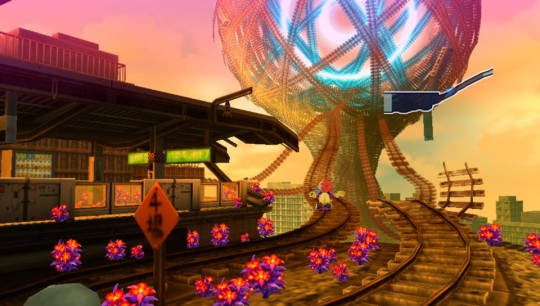
Along the way, you'll encounter the members of an organization known as SKY - initially the villains of the game, you'll eventually become allies in their search for the one with what they call "the power." If you have played any RPG at all, I'm sure you can figure out just who that is. There's also a large variety of secondary characters, but overall, the game's plot isn't very innovative, but it's serviceable. What surprised me, however, was just how dark some scenes were. In one instance, you cooperate with the Japanese military in order to stop a massive dragon-made cannon, only to watch dozens of your fellow soldiers die in front of your eyes.
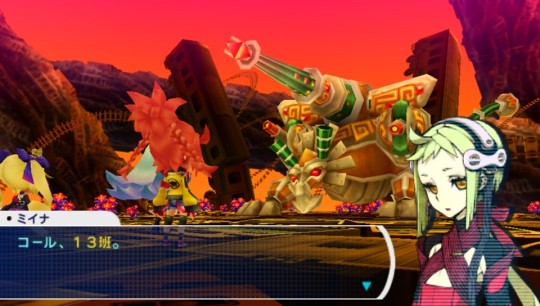
7th Dragon isn't afraid to kill off your friends, either - there are sections in the story that are utter bloodbaths. Certain characters the game seemed to favor early on are promptly killed off at random, and the way the survivors react to the trauma of losing their companions is a major story-point that resounds throughout the later chapters of 2020. I was surprised as to how the allegiances between the cast shift as the game progresses - their relationships, and the way they evolve was, to be honest, way more intriguing than the main plot of, "Dragons are bad."

7th Dragon also features a base development system, in which you'll use materials gathered from defeated dragons to add new weapons to shops, create more residential spaces for refugees, and unlock optional side-quests. You can also recruit Hatsune Miku, because of course you can. Why wouldn’t you? Doing so unlocks a remixed soundtrack featuring said vocaloid, but nothing else. It's a curious addition to the game, and the re-done tracks are pretty cool. Unfortunately, the side-quests in 7th Dragon tend to have poor rewards and vague objectives, so I abandoned doing them around halfway through the game.
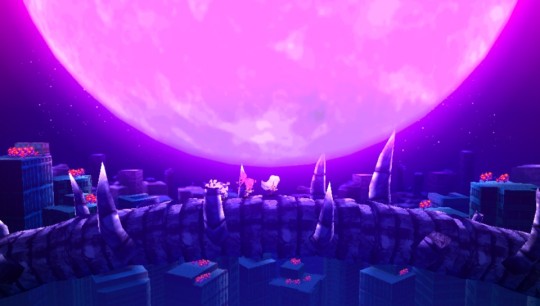
I can see fans of the Shin Megami Tensei and Etrian Odyssey series finding a lot to love in 7th Dragon. Creating a party that works well together is extremely satisfying, especially given the high level of challenge the game has during boss battles. The plot isn't anything impressive, but the ensemble cast and the blood-soaked shenanigans more than make up for it. I can confidently recommend this game to anybody who seeks a marginally less horrifying version of our current apocalypse. But who knows? If 2021 brings us dragons, I can only pray they eat me first.
#gaymer#review#jrpg#7th dragon 2020#7th dragon series#etrian odyssey#shin megami tensei#smt#psp#sega#hatsune miku#apocalypse#gaming blog#game review#retro gaming#retro game
14 notes
·
View notes
Text
#16: アンジェリーク 魔恋の六騎士 / Angelique: Maren no Rokukishi
Angelique: Maren no Rokukishi was a visual novel released by Koei in collaboration with Otomate, a developer of many otome games within Japan. It follows the story of Teresa, a young girl whose parents went missing when she was very young. She lives in the city of Siva with her adoptive family - an unnamed grandmother and her annoying brother, Renaud. After hearing strange rumors about a series of kidnappings within the city, she falls victim to a masked assailant later that night, only to wake up in her room a day later with no recollection of what had happened to her. Read on for drama!
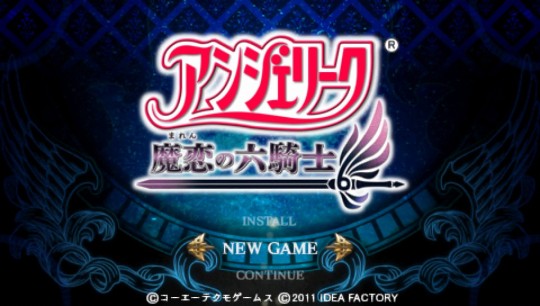
Her brother disappears too, and Teresa beings to desperately search for the boy. She soon finds him within the company of a band of traveling mercenaries. She pleads for him to return, but Renaud refuses, pledging his loyalty to the captain of the mysterious group, Leviath. Faced with a lack of options and her brother's stubborn reluctance to return home, she begs the one-eyed weirdo to serve as his assistant, as Renaud is prone to exhaustion and illness. He agrees, and soon Teresa finds herself on an interstellar adventure, supporting the knights as they serve various clients.
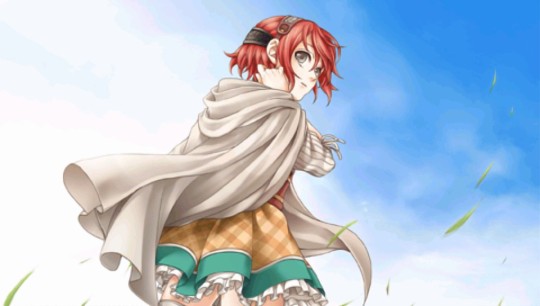
Maren no Rokukishi focuses on the nature of war. When is violence justified? Is it worth it? Do the ends always justify the means? The game explores all of these at some point, and overall, its surprisingly cynical and dark, in a sharp contrast to the colorful art direction. Family ties are broken, betrayals abound, and the action sequences are surprisingly well-written. There are sections in Maren that I found myself completely absorbed in the writing - despite being the type to skim fight-scenes, especially those written in a language that I am not a native speaker of.

Unfortunately, most of the above happens in the final hours of the main route - the rest is simply not that interesting, primarily due to the focus on Renaud. So much of Maren revolves around him, and quite frankly, he is easily the worst member of the cast. Renaud is whiny, naïve, occasionally bratty, and has an incredibly irritating voice. He collapses at the slightest bit of effort, and yet everybody in the cast dotes on him and sees zero no issue with letting him lead his own army. Make no mistake, this is not Teresa's story. It is his.

When you're not experiencing Renaud's latest temper tantrum, depressive episode, or fainting spell, you'll be treated to amusing slice-of-life vignettes of Teresa adjusting to a mercenary lifestyle. You'll be harassed by a drunk, attacked by bandits, threatened with your life at the slightest suspicion, and so forth. Like I said earlier, Maren really only picks up in the final hours, where the shit hits the proverbial fan and characters start dropping like flies. The ending is honestly shocking in how far it plunges into campy tragedy - think Game of Thrones, but actually entertaining. I said what I said.
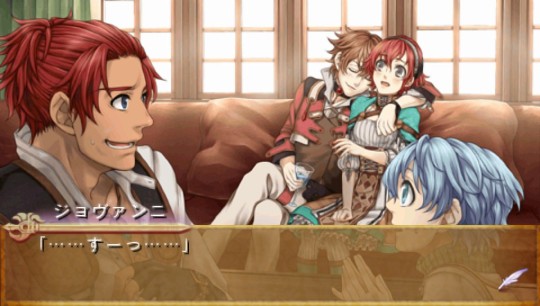
Thankfully, the other routes solve the Renaud issue entirely. But there is a caveat: in order to unlock these routes, you have to complete the main story first. I am of two minds about this feature. On one hand, I think its interesting that the designers have you experience their fantasy epic before allowing the player to romance their favorite knight, but on the other, I don't think that Maren's "canon" story is strong enough to justify it - there's just too much focus on one character, and he's not even remotely likeable. I did some research before writing this game, and found someone who agreed with me, saying, roughly translated from memory, "...but there was too much Renaud, so I'm taking off a star."
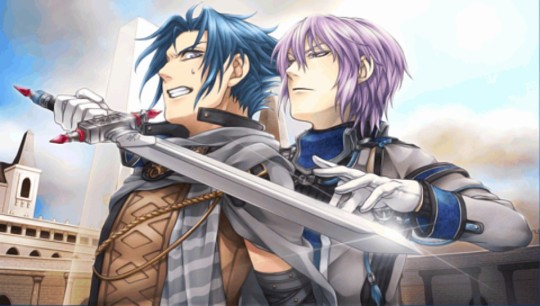
The individual routes are much stronger. My favorite of those that I've played was Giovanni - he's basically the ultimate twink: a hard-drinking, gambling, blackmailing scammer who loves trouble. His route is very light-hearted, which was a welcome relief from the drama present throughout the rest of the game, and his playful nature reminds me a bit of a particular ex of mine, so I'm naturally a bit biased. The main conflict in his route occurs during their second date: he carefully arranges a luxurious all-day experience with Teresa. They go to the opera! He gives her a new dress! A fancy restaurant! Flowers! It's amazing!
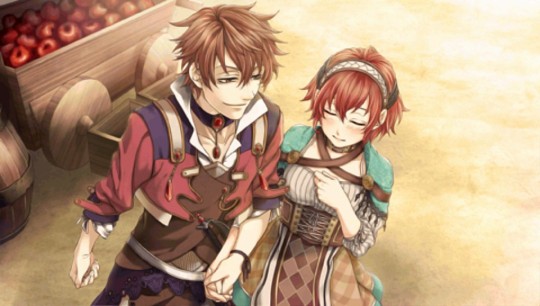
It is then revealed that he was able to go to such excesses because he scammed rich people out of their money. Teresa, for whatever reason, is appalled at this, and basically tears him apart, making a huge scene in public, even - and I was completely dumbfounded. This might be a bit too political for a gaming blog, but I personally would have no issue with someone I am interested in romantically treating me to a five-star experience through some rich asshole's money. They'll be fine, they're rich - who cares? It would be one thing if he was beating up orphans in the street, but Giovanni only targets those who can afford a little blackmail. He is the ideal husband. Teresa should deal with it.
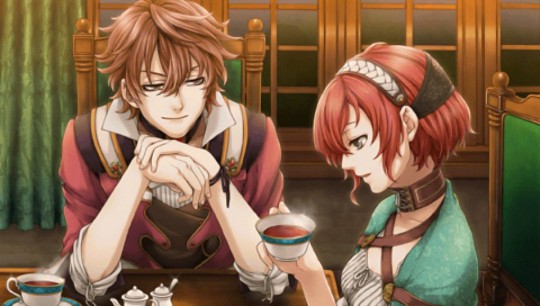
Kiefer's route was incredibly moving, albeit in a more personal way - this blonde mad lad is absolutely insane, and for a good part of the story, Teresa is left unsure as to whether or not he wants to love her or kill her. With most characters of this type, they quickly warm up to you, but Kiefer is different: if Teresa expresses even something even slightly disagreeable in his mind, he would not hesitate to slaughter her on the spot. He is also the character I'm most attracted to, and that says a lot about me and I don't want to talk about it.
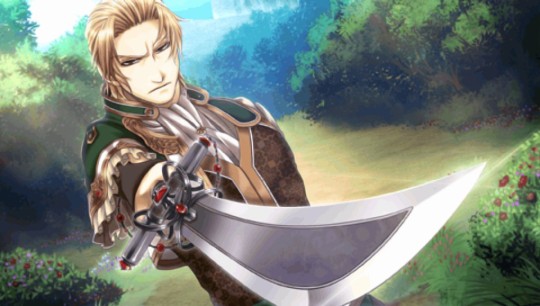
As I said earlier, Maren has a streak of denying the supposed inherent value of family, and there is no greater example of this than in his route: Kiefer kills his brother, an adorable himbo struggling to adjust to high society, in cold-blood, and then attempts to do the same with his father, who, as we find out, tended to dote on his twin-brother. As someone who has been disowned by my own family, Kiefer's rage resonated with me. We, as children, take in our parent's biases, for better or worse, and when we cannot live up to them, it creates a disconnect. I have not spoken to my family in nearly five years. I could understand and identify with Kiefer's rage. I wouldn't go as far as to kill my own family, but who knows what would have happened should I not have left my home town?
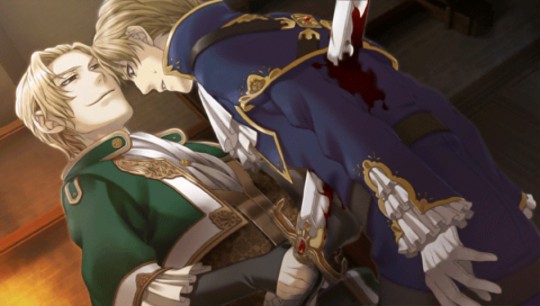
I did not know this when I first began playing Maren, but the game is an adaption of a light novel released after Angelique: Tenkuu no Requiem, which is itself an RPG spin-off of Angelique Special 2. This makes Maren a spin-off of a spin-off, but despite that, I still had plenty of fun with the game - I just wish the main route was realized a bit better. I usually like to replay certain routes to better formulate my opinions, but Maren focuses entirely too much on a character I could not stand. I'd definitely recommend this to fans of Angelique, particularly the sequels mentioned above, as I'm sure the game contains all sorts of references to the source materials, but on its own, it's a bit lacking overall. That being said, as much as Maren lacks, there are certain scenes that were so well-done that I found myself genuinely moved. It's an uneven experience, but one worth looking into!

#otomate#ruby party#otome#otome games#visual novel#fantasy game#retro gaming#gaymer#review#angelique#angelique series#played several other routes but this review was long enough
13 notes
·
View notes
Text
#15: 幕末降臨伝ONI / Bakumatsu Kourinden ONI

Bakumatsu Kourinden ONI is a direct sequel to Kishin Kourinden ONI, released around 2 years after the latter. Bakumatsu is an upgrade to its predecessor in many respects, and is definitely the stronger game of the two, but some baffling design decisions are present, including ones it shares its with predecessor. Set in the Bakumatsu period of Japan, an era where the shogun's influence over the rulings of the country would come to an end, we play as a group of monster-hunters working for the Shadow Shinsengumi - a secret police dedicated to protecting the country from all sorts of beasties. Our main man is Yamatomaru - originally from a small village, he would attract the Shinsengumi's attention after saving some of the village children from winding up as monster-food. Brash, foul-mouthed, and good-hearted, he is essence of a typical shounen-style hero.

After being soundly defeated by a monster seeking revenge for his slain friend in his hometown, our hero is saved by the enigmatic Jurouta, who invites the young boy into the shogun's service, stating that he has the proper qualities of a monster hunter. Initially reluctant, Yamatomaru, determined to become a strong warrior like his deceased father, meets up with the handsome man and accepts the offer. As more and more monster related incidents occur. it becomes clear that certain hot-spots of spiritual energy, what the came calls "spirit pits", are going haywire, giving rise to all sorts of calamities within Japan. Furthermore, a mysterious foreigner with dubious intentions, Riche, is also seeking out the spirit pits, and is willing to do anything to obtain control of them.
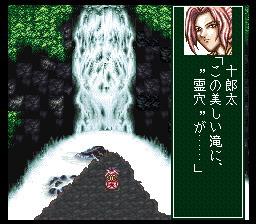
Our heroic twosome is soon blessed with the addition of the Saigami siblings: Natsume and Touya. The Saigami clan is reknowned for their spiritual prowess - including the ability to seal away the raging pits. Natsume is deeply insecure in her own power, however, and for the first half of the game, the party heavily leans on Touya to do what is needed. We are later in the game joined by Squanto - the former leader of a ruined nation due to Riche's machinations. A man of few words, he is a solid tank of a character, dedicated to defeating the colonizers that ruined his way of life.

As charming as this cast is, I felt that, outside of their initial introductions, the game doesn't bother to develop the cast much. Yamatomaru begins the game as a hot-headed himbo, and shows little growth throughout the story. Jurouta is the same, save for the revelation that he is actually a she, causing Natsume to question her tastes when it comes to her love-life, as she is enamored with the stoic warrior. Touya is the typical over-protective brother to a T, but subverts this trope at the same time in an interesting way: instead of coddling his sister whenever she expresses insecurity about her abilities, he empowers her. He encourages her. It's very progressive, especially for a game of this age.
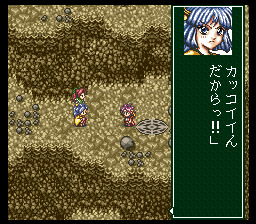
As one can see, the scope of Bakumatsu is much larger than the previous game, and overall, has a much darker tone. The story, at times, is relentlessly tragic: in one instance, you are forced to battle a former colleague of the Shadow Shinsengumi after he willingly transforms himself into a monster in order to prove himself - in another, you watch helplessly as an entire civilization is genocided off-screen. While Kishin wasn't afraid to showcase the occasional tragedy, it never goes as far as Bakumatsu. This is a dramatic game, and I commend the writers for going where others would not.

The narrative is focused: unlike the vignette-heavy style of Kishin, Bakumatsu is fast-paced and dynamic - allegiances shift at a breakneck pace, and as soon as one threat is vanquished, another rises to take its place. It feels exciting to play. The dungeons are, for the most part, short and snappy. I remember the dungeons in Kishin being an absolute chore at times, as the game would frequently chain multiple locations together with little plot to entice the player to continue on. While Bakumatsu does feature the occasional marathon sequence, the player is always provided with plenty of cut-scenes and opportunities to save and recover.

That being said, the game lacks in dungeon variety. Almost all of the dangerous places you'll visit in Bakumatsu are mountains, with only a color palette to differentiate them. It's boring. I found myself rushing through these levels, mashing the fast-forward button and avoiding thorough exploration. I understand the memory limits of the Super Famicom, but it still feels lazy. And while they are a definite disappointment, the rest of the graphic design in Bakumatsu excels. Your characters are superbly well-animated, full of personality and character. During the latter half of the game, your party travels across the sea to the New World - and it truly feels like a different continent! The level of detail in the map of a game this age managed to really surprise me, and I loved seeing my home country portrayed through the eyes of a different culture than my own.
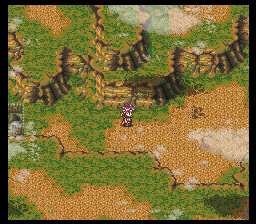
Bakumatsu features an upgraded combat system. Each character has a variety of sword-techniques that use their own MP gauge which is restored by walking. They're are all super well-animated, flashy, and just plain cool. Even the most basic moves are stronger than your standard attack, so even the ones you acquire early on retain their usefulness throughout the entire game. The standard magic spells and summon abilities have been upgraded graphically, too, making the battle sequences, as a whole, feel much more exciting and dynamic.
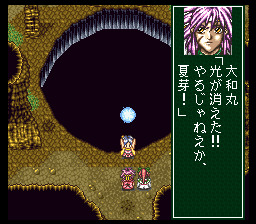
Which is great, because like its predecessor, the encounter rate in Bakumatsu is disrespectful. Battles occur every couple of steps, and enemies are, due to the expanded combat mechanics in comparison to the previous game, often take a bit longer to defeat, as they tend to have an immunity to either magic or physical attacks. Remembering these characteristics is a matter of memory, as there are no spells available to identify weaknesses. Despite this, the overall difficulty level in Bakumatsu is much more reasonable than in Kishin - there are only two instances in which I had to stop and grind out some levels: once in the very beginning, and another near the very end of the game.
There are two other types of encounters that are worth discussing: the ship battles, and the underwater battles. Once you acquire your ship, you will, at times, run into other sailors that want nothing more than to send you to a watery grave. Your ship functions as a character would - it gains experience and levels up as you defeat enemies, but you must spend a pretty penny at the Yokohama docks for it to be upgraded. These oceanic encounters are novel for their time, and amusing enough, but suffer from balance issues. The first time you embark out onto the sea, you will have no way of knowing which ships you can take on, and which ones you have no chance against. It's a matter of trial-and-error, so frequent saving is recommended.

The underwater battles are similar to regular encounters, but special attacks and spells are disabled, and are instead replaced with a bar that represents how much time you can stay underwater. Should this meter run out, your character dies instantly. Taking damage and attacking foes decreases this meter, but you can choose to surface for air, but doing so will end your character's turn. This presents an interesting "risk and reward" system - the player has to choose whether or not to risk drowning or finishing a battle quickly. I wish spells were available, though. I feel as though it would have been easy enough for the developer's to disable fire and water attacks, leaving the earth and other elements. Some of the monsters you'll find underneath the water's surface are vicious. I've never been more afraid of crabs in my entire life!

Like it's predecessor, there is plenty of side-content to discover throughout the world, including a village-building minigame. Inhabited by friendly monsters you found throughout Japan, you can earn various rewards as it develops into a bustling hamlet. Special summons can also be found, but you'll have to meet special conditions in order for them to lend you their aid. This is where Bakumatsu’s most intriguing aspect comes into the play: the karma system. Depending on your choices throughout the game, you'll be assigned a rank, ranging from "Absolute Villain" to "Godlike" - these can affect whether or not you'll be able to obtain certain allies or spells. Unfortunately, once you reach a certain point in the game, it becomes impossible to influence your rank beyond a certain point. If you're aiming to obtain everything, I'd recommend a guide.

There is a lot to like about Bakumatsu: the game is well-paced, graphically stunning, and I loved how the developers were unafraid to experiment with all sorts of different mechanics. While the execution of these ideas were occasionally lacking, they were novel for their time. Between Bakumatsu and Kishin, if you were to only play one, I'd definitely recommend this title. It's a solid, if occasionally frustrating, experience, dripping with style and visual flair. Definitely recommend!
#retrogaming#retro gaming#super famicom#super nintendo#oni series#bakumatsu kourinden oni#game review#rpg#jrpg#gaymer
2 notes
·
View notes
Text
#14: A Proper Introduction!
Hey, everyone! I know I haven’t written anything for a hot minute, but life has been a bit crazy lately, so I haven’t had as much time for gaming as I’d like. I was given a very sudden promotion at work, and said promotion included a literal mountain of new responsibilities, so most days I’m too exhausted to even do anything but binge watch YouTube and feel sorry for myself.
But I have no intentions of abandoning this blog - in fact, I finally got over this slump and started playing a new game last night! The next game I’ll be discussing is Bakumatsu Kourinden ONI - the direct sequel to Kishin Kourinden ONI, which I (somewhat sloppily) babbled about earlier this year. Kishin was a great, if somehow by-the-numbers JRPG, so I’m looking forward to experiencing what Bakumatsu has to offer. Read on below!

Fun fact! The ONI series started on the original Gameboy, and only made the move to home consoles after four games. I plan on covering those titles as well, as I have always harbored a great love for stories set in ancient Japan. As a student of the Japanese language, I spent a lot of time with old texts, so to have these stories reproduced, even if in a medium that most disregard as inferior, has been incredibly delightful. I am thriving!
As for my background, I started playing JRPGS shortly after I turned 10. My first was Albert Odyssey for the Sega Saturn. To be honest, I don’t remember much about it. I would learn later in life that it was localized by Working Designs, a somewhat infamous company whose works would later be criticized by gamers who felt that they went too far in disregarding the original texts in favor of humor, but as a kid in America, I didn’t know any better. My most vivid memory of Albert Odyssey was how colorful it was - before, I had mainly played games developed in America, and they, as a whole, favored a more natural color palette in comparison to Japanese ones, so it felt very fresh to my eyes. Like a lot of nerds growing up, I didn’t exactly fit in, so seeing the cast tease and support each other lifted my spirits. They felt like personal friends.

I also loved the villains. If I remember correctly, there were quite a few female ones. I know not every gay man is attracted to powerful women, but I certainly was, so seeing women embrace being unabashedly evil thrilled me. I still root for the ladies, especially the evil ones, to this very day.
Albert Odyssey had a very orthodox gameplay system, but something about it hooked me immediately. My older brother was always a pro at anything that required hand-eye coordination, so he loved boasting how he could beat me at “any game”, but he wound up frustrated at Albert Odyssey very early on. He couldn’t figure out the puzzles; he didn’t understand why he couldn’t button-mash through every fight, and he was especially irritated by how slow-paced turn-based battle systems were.
I loved how RPGs, generally speaking, were not competitive games - rather, they were more of an experience, and one that was meant to be explored alone. They were the perfect fit for an introverted dork like me - an entire genre, spanning hundreds of titles, that I could freely enjoy without the presence of my overbearing, hyper-competitive brother. When I started this blog, I had a vision in mind of extensively covering obscure, Japan-only RPGs, but in time, this grew to encompass another genre I fell in love with: otome games. These are generally visual novels primarily targeted to a female audience, but for whatever reason, I fell hard for them. I love dramatic, character driven RPGs more than any other kind, so looking back, it seems only natural I’d be drawn to games of this nature.

As for how I started learning Japanese, I was exposed to Japanese music when I was around 13 (I’m 31 now!), and fell in love with the way the language sounded. I begged and pleaded with my mom to buy me a basic grammar, and started learning by myself a few weeks later. I managed to get farther than most in my self-studies, as I was determined to be able to understand the lyrics of the songs I loved without relying on others: in the process, I developed a true passion for the language itself, which lead me to studying it in-depth once I went on to college. Somewhere along the line, I discovered Japan’s rich literary history, and fell hard for the Heian era - and in a strange mirror to my younger days, I’ve recently started studying classical Japanese in order to, again, understand the poems and stories without the help of another. It has, so far, been an incredibly rewarding experience. My lifelong dream is to become a literary translator, but for now, I manage a Starbucks department in a grocery store. Day jobs, right?

We stan Ono no Komachi in this house.
I’ve ranted long enough, so if anyone reads this, I hope you find yourself well! And please feel free to give me a follow! I’m very new to blogging, so learning how to grow an audience is something that I’m kind of puzzled about. If you’ve read this far, please enjoy this picture of me with my best friend’s adorable kitty. He has no eyes. We must stan.

#gaymer#retro gaming#retro game review#introduction#super nintendo#super famicom#oni#bakumatsu kourinden oni#otome games#otome
1 note
·
View note
Text
#13: 月影の鎖 -錯乱パラノイア- / Getsuei No Kusari - Sakuran Paranoia -
Released in April of 2013, Getsuei no Kusari ~ Sakuran Paranoia ~ is an otome game for the PSP. Developed and published by TAKUYO, GnS is a sprawling, massive tale about the struggles of a small town facing economic decline, xenophobia, taxation, and despair. There’s also a bit of romance, too. As a treat.
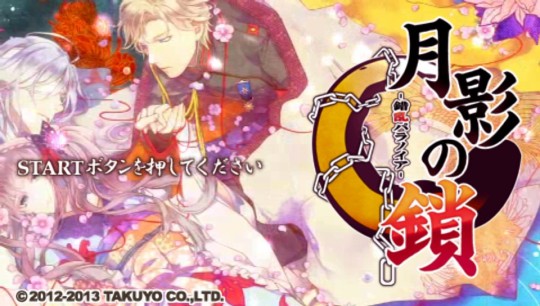
Set in the isle of Sangetsutou, a small island far from the mainland, we play as Fuyuura Megumi, who runs a small restaurant in the island’s only city, Koukashi. Megumi is an excellent protagonist - she’s kind, polite, and very hard-working, but has trouble opening up and asking others for help. Relatable.
But all is not well in this seemingly peaceful town. A massive fire devastated Koukashi a year before the game began, and the town has faced economic issues since. Once known as a tourist destination due to its pleasure quarter and hot springs, the amount of visitors to Sangetsutou has decreased significantly. Faced with economic depression, the town’s unnamed mayor hires a mysterious consultant, Fukami, who offers the town a simple solution: turn the town into a military base. By doing so, Koukashi would not only receive money from the federal government, but businesses, too, would benefit from the presence of soldiers visiting the island and spending their coin. But the majority of the citizens are opposed to this proposal: why should their way of life have to change? Who will really benefit? Is there any other way? What would happen should the country go to war?

Chief among those opposed to the garrison is Kagurazaka Hibiki, leader of the town’s youth activism group and local hero. Originally a traveler, he happened to be in Sangetsutou during the great fire of last year, and is renowned for stepping in and organizing the rescue and extinguishing movements when the town’s government failed to respond adequately. He is well-educated, stoic but likable, and the town has developed a dependency on him to set things right, for better or worse. Working directly underneath him is Mochizuki Satoya, a diligent youth, who grew up in the pleasure quarters, working as an assistant to the brothels there. Like Kagurazaka, he cares deeply for the townspeople, though he struggles with envy, as he feels he does not have the ability to lead others as Hibiki does. He’s also short. He doesn’t like that, either.

Rounding out the cast, we have Inoguchi Wataru and Haruna Nozomu. Wataru works for the military, and I assume he is involved with the militarization of the town, but beyond that, I’m not sure, as I have yet to do his route. Nozomu is initially silent about his motives, but it is eventually revealed that he works for Fukami, but this cynical blue-haired jokester isn’t especially loyal to this colonizer of a boss.

Unlike other otome games, or at least those that I have played personally, GnK isn’t entirely focused on romance - rather, this is a story of a small town trying to cope with economic struggles, with interpersonal drama sprinkled in throughout each route. Each story-path features Megumi siding with a particular faction within Koukashi: for example, you’ll become a member of Kagurazaka’s activism group in his story-line, while in Mochizuki’s, you’ll spend a great deal of time getting to know the women that make their living as prostitutes in the pleasure quarter. Should you choose Haruna, you’ll spend a brief time working the game’s “villain” of sorts - and if you couldn't guess who that is, it’s Fukami. The world of GnK is a morally grey one - each character is extensively developed, complete with many long, long monologues, both spoken and thought, and you’ll gradually discovery why each character does the things they do, even if you don’t agree with their reasoning. The game respects your intelligence in this respect, and the writers are not afraid to discuss serious issues. This is easily the most “mature” otome game I have played. GnK tackles subjects like xenophobia, racism, economic scarcity, suicide, rape, and the validity of the sex work. Furthermore, this is by far some of the most challenging material I’ve ever read as a non-native speaker of Japanese. This game will break your back if you’re not at a certain level of fluency, but I personally loved the complexity of the text. As somebody who has studied the language extensively, I sometimes feel as though my abilities have plateaued in a sense - almost as if I can’t get any better than my current level. GnK wound up being a rewarding experience solely in that sense - but make sure you keep a dictionary on hand!
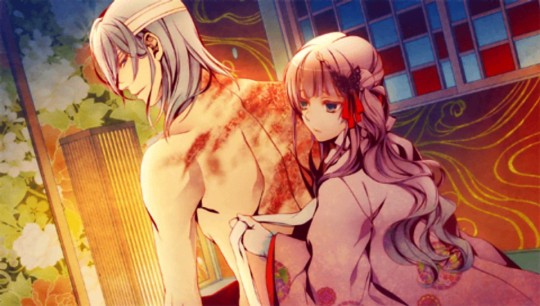
The story, for the most part, is very slow-paced and there’s not much “drama” until the latter half of the game. GnK is a slow-burner, which naturally allows for more opportunities to really explore its characters. However, this does not mean that there’s no filler - there is an absolutely absurd amount of text that I felt could have been left in editing without affecting the story. Do we really need to have multiple paragraphs of Megumi describing, at length, the process of preparing tea every time somebody orders it? I understand that this is a visual novel, so shouldn’t the principle of “show, don’t tell” apply even more in this respect?
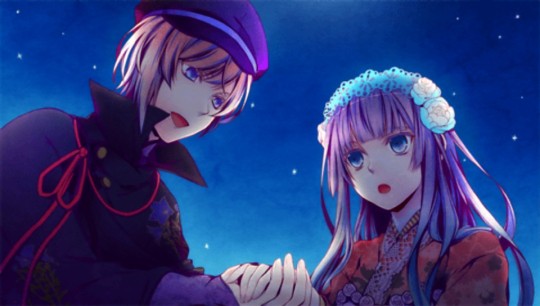
The game is a bit obtuse when it comes to unlocking routes, as well. On my first play-through, I answered each prompt as I would in real life, as I typically do in games of this type, curious to see who I wound end up with in a natural flow of things. This was a stupid idea in hindsight, because GnK has a number of bad endings lurking to sink an unsuspecting gamer. I would up unlocking nobody, and my game ended after only a few hours. Upon reading a guide, I was a little annoyed by how strict the game expects you to be in regards to following each route - but in its defense, GnK does provide an excellent auto-save feature. I was just too dumb to utilize it properly.
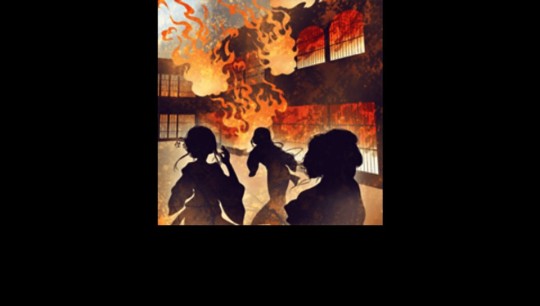
Each protagonist has two “main” endings, and as mentioned above, a small handful of bad ones. Which proper ending you unlock depends on how high the “love” and “dependent” your man of choice has for you. Being self-less, strong willed, and honest tends to raise the “love” meter, while doing the opposite raises the “dependency” level, but it, of course, depends on the character.
The love endings are full of the schmaltz you’d expect from a game of this type, though slightly elevated thanks to the high quality of the writers at Takuyo. The dependency endings, on the other hand, are absolutely wild, and genuinely disturbing - you’ll experience the exquisite pleasure of burning together in the pleasure quarter, or, conversely, know what it’s like to strangle another human being after you’ve lost your marbles due to experiencing the same trauma your birth-mother went through! They are the definition of extra, and as a whole, felt way way more fulfilling and unique compared to the happier endings.

I wish the game had actual split routes for the two ending types, however, as seeing a healthy-ish relationship crumble within a span of minutes felt a little jarring to me, personally. That being said, if you only have time for one ending, go for the dark ones, as they really pack that molasses-drenched punch.

I love when a game manages to truly surprise me, and GnK did that. The plot, grounded and realistic, free from paranormal influences or deus-ex-machina bullshit, felt super fresh compared to many games in the same genre, and the depth of text kept me challenged and entertained. Each route will take about 10 hours - so it’s well worth trying out! Stay safe out there, and happy gaming!
#getsuei no kusari#otome game#otome#visual novel#historical game#playstation portable#psp#gaymer#retro gaming#retro game review
2 notes
·
View notes
Text
#12: 聖剣伝説3 / Trials of Mana
I really don’t like being negative! I’m not shy about giving criticism, but I have yet to review a game that I did not vibe with whatsoever. I tend to like most things! That is, until I played Seiken Densetsu 3. I straight up do not like this game, and it’s a little heartbreaking to say this, because SD3 gets a LOT right, but everything falls apart in the core game-play loop.

My biggest issue is the combat: there is a serious delay between entering a command having it play out on screen. I’ve noticed attacks taking several seconds to register - which makes planning any kind of strategy nearly impossible. Furthermore, by using the shoulder buttons, you can control your other part members and access their abilities, but whether or not this actually worked or not seemed entirely random. I’ve had game-overs happen because of this, and its very frustrating to feel as though you have no control over what’s happening on screen.

Combat is also incredibly tedious and repetitive - during the first quarter of the game, you’ll only have access to a handful of spells and special moves, and even those are unlocked through plot progression. Using these spells pauses battle as the animation plays, which makes an already sluggish system feel even more unintuitive. The game perks up a bit during boss battles, as they often feature changing environments and multiple forms, but these suffer from a lack of real strategic depth. Mainly, the problem is with positioning: A boss will occasionally telegraph a particular attack, so one would assume, due to SD3 being an action RPG, that you can dodge or avoid the attack somehow.

Not the case! If SD3 decides something is gonna fuck you up, there’s nothing you can do about it! And despite their glossy trappings, bosses aren’t all that much different than regular ones - all you have to do is debuff, attack, and heal. The same strategy will carry you far, and I felt no desire to experiment because I had no reason to do so. If SD3 had even the simplest guard and block system, everything would feel a more dynamic. But as it is, it feels flat. Dungeons are bit too long - exits and entrances are often hard to find, and I often found myself stuck running around, completely stuck, for absurd amounts of time. There’s little variety in their design, and honestly? They’re not fun. What makes them worse is that treasure chests are only found randomly after battles, so there is literally no incentive to explore around. I got real sick of it real quickly. Definitely use a guide.

All of this could perhaps be forgiven if the plot was strong enough to carry the flaws, but there’s just not enough content. There are a small handful of playable characters, each one with a unique opening scenario (and I assume ending?), but in between? There’s just not enough meat. You’ll occasionally run into your character’s nemesis, but for the vast majority you’ll be chasing after the next elemental boss beast or befriending cutesy sprites. I chose Riesz for my main character, and I actually really liked her! After her kingdom is taken over by a mysterious woman named Isabella, she sets out into the world in search of revenge and her missing brother, who was captured during the invasion. Riesz has a quick temper. but a strong sense of justice, an inability to let evil go unchallenged. Again, I just wish there was more development! But due to this being an SFC game, there may have been memory issues, since each character would need to have extra lines written for them..

The other heroes I chose were Hawkeye and Charlotte. Not going to lie, I barely remember anything about Hawkeye, because your team, unfortunately, gets even less screentime than your protagonist. Charlotte, on the other hand, was an utter mistake. I don’t understand what possessed me to have this creepy hobbit-thing join my team, but she sucks. Her speech impediment is not cute at all, and outside of healing, she’s kind of useless in battle. SD3 features a class change system, and its one of the few aspects of the game I have no complaints about. Each character gets their own unique skillset in each class, and they’re divided into light and dark categories. Light classes tend to be more support based, while dark classes focus more on offense and spells that lower your enemies’ stats. I can already imagine the possibilities for challenge or themed runs! I, being the idiot that I am, chose to make my entire down the dark path. This lead to my team being pretty unbalanced. I wonder if I could have had a better time with the game if I hadn’t decided to be an edgelord. I highly recommend researching each character’s potential growth paths!

Overall, SD3 is a mess, a beautiful mess, but not something I can recommend unless you’re willing to deal with how tedious the game can be. I can appreciate the ideas it has - nothing else plays quite like it - but the execution, for me, fails on many levels. I’d love to play the remake eventually, but I’d recommend staying far away from the original.
#trials of mana#seiken densetsu 3#mana series#jrpg#super famicom#snes#retro gaming#retro games#gaymer#squaresoft#i tried to love this game lovs i really did x
1 note
·
View note
Text
#11: サクラ大戦
Originally released in 1996, Sakura Taisen is an absolutely fabulous, light-hearted romp through 1920s Japan. You play as Ogami, a young military offical assigned to lead a group of young theater actresses who pilot mechas designed to fight against all sorts of monsters who threaten the safety of Japan.

Pardon the graphical glitches in the above image. I’m not a scientist.
Sakura Taisen features an interesting mix of tactical RPG and a visual novel. You’ll spend most of your time working at the theater where the group resides, helping out with various tasks as you get to know the ensemble cast. What separates Sakura Taisen from other games of this type is what the game calls the “LIPS” system. I do not remember what this stands for, and I am too lazy to find out.
Essentially, unlike most visual novels, the dialogue choices in SW are timed - and the game is not shy about throwing you into situations in which you only have seconds to respond, and before you even bother to ask, no, you cannot pause the game during these sequences. Sorry!

Answering correctly will raise the respective character’s affection level, which carries over into the battle sequences in the form of various buffs. Pissing them off will do the opposite. Interestingly, sometimes saying nothing at all is the correct option. Just like in real life! And just like real life, I always panic and usually blurt out exactly the wrong thing. I’ve played a few visual novels, so by now you’d think I’d have a good sense as to what the correct option is, but no! I’m still helpless!

The cast is likeable - I’m especially fond of stuck-up Sumire and Kanna, her tomboy counterpart. These two straight-up come to blows at certain points, and they’re some of the funniest scenes in the game. The game’s titular heroine, Sakura, is a bit bland, but inoffensive and pretty enough. The only character that I cannot stand is Iris - the token child character, who, OF COURSE, immediately develops a crush on Ogami. There is a lot I could say here, but the last thing I want for this blog is to attract THAT kind of discourse (you know what I’m talking about), so I will just say this: I don’t like children. I don’t like Iris, neither her design or personality, and every time she’s on screen I begged for her to go the fuck away.

Sakura Taisen presents itself in an episodic manner, similar to a real anime or television show, complete with previews! This was one of my favorite aspects of the game, and one I wish others utilized more. I found myself playing until late at night often - the “just one more episode” effect is in full, sleep annihilating force, and I loved every second. Unfortunately, the game’s pacing is a bit wonky once the battles begin. Fights in Sakura Taisen play out like a traditional strategy RPG, complete with grid based movement, special attacks, and a decent variety of scenarios: my favorite thus far is a battle rather early on, in which the boss will randomly summon one of your allies within his attack range. Scary!

But, as in most SRPGs, the flow of battle is unbearably tedious, watching each character s l o w l y take their turn is mind-numbing, and I found myself dreading upcoming brawls. Strategy fans won’t mind, but I have never been fond of the genre - the time investment required for each stage just a bit too much for someone like me. I have the attention span of a confused goldfish. Sakura Taisen also features a variety of mini-games that you’ll encounter throughout your adventure, including a cooking game, an isometric platformer where you sweep the floor with Sakura, and an utterly incomprehensible card game forced onto you by Kouran, the kansai-ben speaking genius. To the game’s credit, I was fairly drunk and button mashed my way through the tutorial. Anyway! These are all pretty fun, and provide a welcome distraction from the main flow of the game.

I can’t speak much about the plot, as I have yet to complete it, but it follows our heroes fighting against a mysterious group who intend to conquer Japan and expel the Western influences they feel have tainted the country. Once again, there’s a lot I could say here, but I’m not trying to attract THAT kind of discourse to this blog, either. Nobody is getting cancelled today! That being said, there’s a fun “monster of the week” feeling with Sakura Taisen, and as someone who grew up with anime like Sailor Moon and Dragon Ball Z, the game overall feels very nostalgic.

Even though I generally dislike strategy RPGs due to their pacing issues, the other elements in Sakura Taisen more than make up for it. The game is literally a playable 90s anime. The game never takes itself too seriously, and the sometimes chaotic chemistry among the cast never failed to have me grinning like an idiot. A perfect game to chase away the quarantine blues. I heard it was recently translated into English, so check it out!
#sakura taisen#sakura wars#visual novel#strategy rpg#srpg#sega saturn#gaymer#Retro games#retro gaming#sega#game review
2 notes
·
View notes
Text
#10: Romancing SaGa
I’ve always struggled with open-ended games. I’ve found that when I’m left to my own devices without any particular end goal, I often get frustrated and quit. I tend to prefer games with a stronger, more central narrative - which is the exact opposite of what Romancing SaGa offers to the player. I decided to check this title out because of its immense Japanese fan-base - there are so many YouTube videos covering this game, and I was left very curious as to why this game is so beloved in its home country.

You begin your journey throughout Mardias by selecting one of the 8 main characters. Each one has a unique backstory, personality, and ending. For my first run, I chose Barbara, as I loved the idea of being a mysterious traveling dancer (I am a massive homosexual).. On the second, I went with Claudia, a young girl raised deep within a mysterious forest by a rather ornery witch. Each character has their own unique opening sequences, and while I wish these were longer, I still find myself enjoying getting to know the large cast.

Once you finish the opening quest, you are left entirely to your own devices. The world of Mardias is large, with several distinct cultures that vastly differ from one another. While the lack of a central narrative bothered me at first, the game became much more immersive once I found myself wound up in one of the game’s many different sub-quests. These quests offer a good deal of variety for a game of its age: my personal favorite was rescuing a village who had been turned into the undead. In order to save them, I had to sniff out the artifact known as the Holy Grail, which was located deep within the catacombs of an entirely different city. I loved that! There’s a huge incentive to explore, to talk to everyone, to really get to know the land: the lore isn’t explicitly laid out for you: it’s something that has to be discovered.

Some of the quests feature morality choices, which will either raise or lower a hidden set of morality parameters - opting for violence, stealing, or outright murdering some bastard will lower them, while doing the right thing, such as refusing a reward, will increase your standing in the eyes of God. As far as I can tell, these don’t affect anything other than which dungeon will lead you to the final boss. I wound up going through the “good” dungeon, as I’m a cowardly Taurus and don’t like being mean, but others may prefer to be a bit more dastardly.

As the game progresses, certain events will open and others will close. This is entirely dependent on how many battles you’ve fought, not by actual gaming time. The limits, with a few exceptions, are fairly generous, and I was able to complete most of the events that I discovered throughout both of my runs. Unfortunately, avoiding fights is incredibly difficult: SaGa is not afraid of throwing wave after wave of monsters at you, often with unpredictable movement patterns, leading to consecutive encounters. I cannot remember exactly, but running away seems to almost always work, but given the game’s often claustrophobic dungeon design, avoiding enemies is matter of luck. There’s something quite horrifying about seeing massive walls of enemies rush to slaughter you, but it gives each dungeon a sense of real danger, which is often lacking in games of this era.

Speaking of, the “regular” enemies in SaGa are often extremely difficult. You’ll soon learn which ones are worth fighting, and which ones are not, as the more difficult foes will naturally drain your limited resources. And given how often you’ll be running into them, I recommend saving very often. Certain enemies can wipe your party outright if you’re not prepared - there’s a late-game absolute beast of a foe that will only spam your party with devastating AOE attacks in a game without group-healing. They often come in packs of three. Thankfully, you can usually retreat and “re-roll” for an easier encounter, but if you aren’t well-versed in what your foes are capable of, you’ll soon find yourself in the grave. Just like my career!

In contrast, I cannot recall a single boss that gave me much trouble, with the exception of the ultimate big bad. Saruin is an absolute monster, and I dedicated almost half a day of grinding in order to beat him! While it made for an extremely satisfying victory, I can see why some would rather not bother, as grinding isn’t necessary for the rest of the game. The difficulty spike makes for a disjointed final chapter, but SaGa graciously allows the player to grind infinitely without any penalty.

Fortunately, SaGa gives you plenty of options to vanquish your opposition. There’s around eight different schools of magic your characters can learn, and a slightly smaller variety of weapon types. Each weapon has its own level, and special techniques are earned upon reaching certain numbers. There isn’t a visible EXP system, so upgrades seem to come at random - this is a bit frustrating, especially late-game, where things seem to really slow down.
That being said, the game is riddled with bugs. While I noticed few throughout my experience, a quick look on any Japanese fan-site reveals a whole slew of them. My favorite one I encountered was when the whole screen glitched out near the end of the battle with Saruin. Stunning!

Unfortunately, I don’t think I can recommend SaGa to most gamers. The frequency of battles, coupled with the opacity of many of the game’s systems, leads me to believe that many won’t find this title appealing, which is a shame, because when SaGa is good, it’s good. There’s an incredibly rich world to explore here, and the game does not lack with regards to content. There are many quests I haven’t experienced, even with multiple playthroughs. If you’re an irredeemable geek like myself, please check it out!
#romancing saga#super famicom#rpg#saga series#super nintendo#game review#gaymer#old school gaming#retro gaming#retro games#square enix#squaresoft
5 notes
·
View notes
Text
#9: Angelique Retour
Angelique was one of, if not the very first, otome games to hit the markets. Developed by women for women, it became incredibly popular in its home country of Japan, but has yet to see any overseas release. As someone who is still new to the genre, I thought it would be interesting to try one of the earlier games, and while I do intend to play the original eventually, I decided to get my feet wet with the PSP remake of the first title, Angelique Retour. Spoilers below!
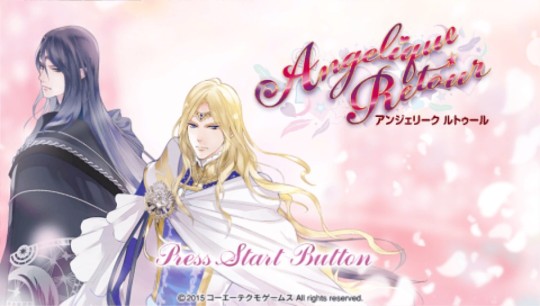
As Angelique, you are selected to participate in a trial to determine who will become the next queen of the universe. You are responsible for guiding a fledgling society into a proper civilization, and this is achieved through relying on a group of 9 guardians, who, of course, also happen to be eligible bachelors. It’s a pretty simple premise: not much else happens throughout the course of the game, but it works. Sure, there’s some hand-wringing and navel-gazing about the choice between love and duty, but not much. At its heart, Retour is much more of a social simulator than a hardcore raising sim.
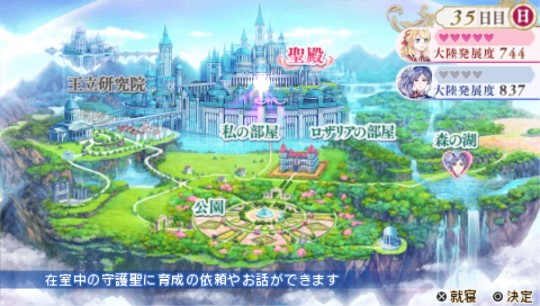
Each week, you’ll visit your section of the continent and receive a report from your people detailing what kind of energy your society needs. You then simply ask the respective guardian to help, and voila! This is how you’ll beat the game. You technically have competition in the form of your rival, but as long as you do the above, you’ll be able to easily crush her. While I was doing research on the Angelique series as a whole, I read several accounts from players that stated the later entries were quite harder, with one title in particular offering difficulty levels! I wish they had implemented that for Retour, as once you grasp the basic concepts, everything becomes painfully easy.
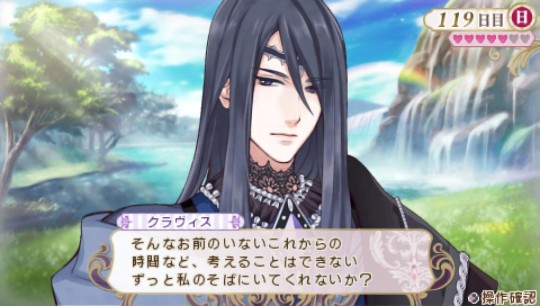
While the simulation aspect of Retour is a bit too simple for my taste, the social systems are a lot meatier, with quite a bit of depth to them. Each guardian has their own attitudes towards you, the competition, your rival, and other guardians. A few of these can even change throughout the course of the game, and you’ll only discover how they’re feeling by either asking them directly (costing you energy points) or asking other guardians what they think of your eventual paramour.
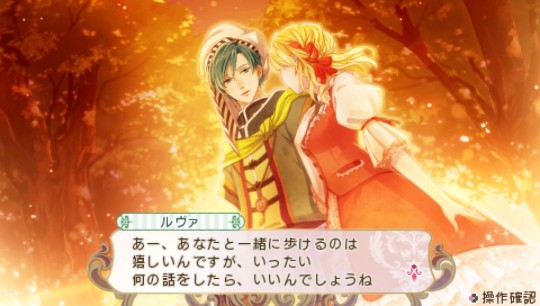
These matter, as many events only occur at the successful completion of a “park date”, the closest thing the game has to a boss battle. During these excursions, you are essentially interrogated on a variety of topics, ranging from the competition, what guardians your rival is close to, what dessert you made for the last tea party, and so forth. The correct answer depends on how your beau feels (and your memory, obviously.) Failing any of these questions will ruin the date, and will lock you out of any special events for that day.
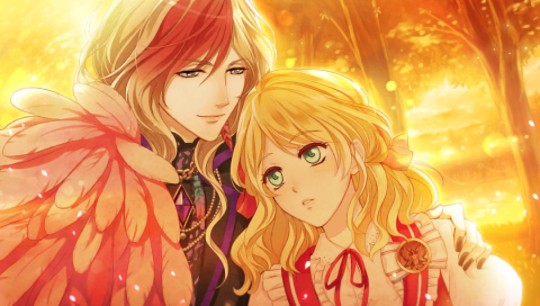
While some may be tempted to save before these dates, I found it much more fun to really snoop around, inviting whatever guardian I was interested in on the less intensive dates to really get to know them and taking lots of notes. It’s fun to be a stalker! You can also give gifts, but it’s fairly easy to figure out what each guardian prefers, as their descriptions usually give a hint or two.
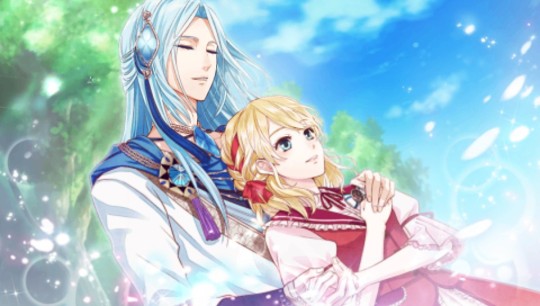
As always for Ruby Party, the cast is stellar and superbly written. As a linguistic nerd, I loved the variety in speech styles and vocabulary choices and how much it revealed about each guardians personality. What I felt was lacking, however, was a sense of conflict: the guardians don’t really have much of a story arc - at least not in the vein of say, Neo Angelique Special. Some events are easily missed, giving you less of a story, which is a real shame as there isn’t a boring boy in the bunch. Given the level of freedom you have in who you associate with, I found myself thinking of all sorts of “themed” challenge runs. Right now, I’m laying low, waiting for Rosalia to get close with a particular guardian, so I can swoop in and steal him from her.
Because I’m gay and petty.
Rosalia is a nasty rival, constantly berating you and just generally being shady. I’m looking forward to ruining her life! According to my research, there was a version of the original Angelique that let you play as her, so I’m looking forward to trying that one out!
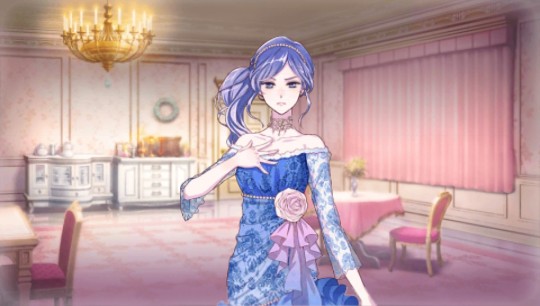
Given how much I’ve enjoyed their titles thus far, I’m really starting to wonder if Ruby Party has ever made a bad game! While it can feel repetitive at times, the cast (and beating the absolute crap out of Rosalia in the competition) made it a joy to play. I wish getting all the events was a bit easier, but that’s a small demerit against an otherwise incredibly enjoyable experience.
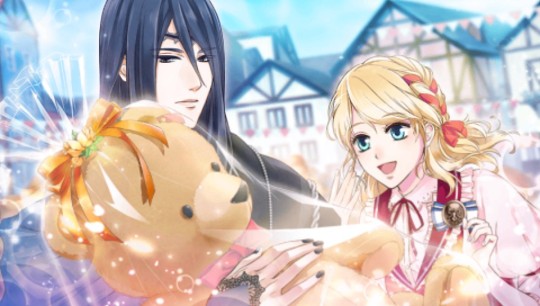
3 notes
·
View notes
Text
#8: 天使の詩~白き翼の祈り~
It’s rare to find RPGs, Western or Japanese, that focus heavily on romance. There may be romantic subplots, but they are often shoved into the sidelines, usually in favor of whatever worldwide disaster that threatens all of existence. Tenshi no Uta is different. This game is heavy on the romance, and I found myself enthralled from beginning to end. Tenshi no Uta is a hidden gem.

We play as Reynard, a young man who lives in a small village with his father, a humble blacksmith. One day, a group of traveling entertainers come to lift the town’s spirits. It is then when we meet our heroine, Clarna: a talented songstress, who fell in with the traveling gleemen as a way to discover the identity of her parents, of which she has no memory. The two fall in love immediately. Within the first few hours of the game, Reynard and Clarna are pledging vows and dreaming of their future together - they stop just short of declaring their intent to marry. It is very cheesy - but I have to admit: I love how Tenshi no Uta is unafraid to wallow in sentiment. In fact, the overall atmosphere is very reminiscent of an otome title, albeit with a male protagonist.

The romance doesn’t stop with our young lovebirds - all of your party members have their own problems in love: Sofia, our healer, fancies the warrior Leon, who is blind to her feelings due to his desire for power. Levi, the hilariously foul-mouthed mage, refuses to settle down with his paramour until he gets revenge for his mentor’s death. And then there’s Gilda, whose wife pleads with Reynard to avoid talking about his travels, as she is terrified of losing him after he was injured during a previous experience with the young lad..

Tenshi no Uta explores all sorts of love - how it can hurt, heal, and even frighten us. It’s heavy on the schmaltz, and not superbly written, but I found myself rooting for these characters. This brings me to my next point: the main plot, outside of the gooey romance, is fairly dull. You have the standard villain, the secret villain, and then the Ultra, Last Minute Super Villain! There are magical artifacts to collect and unsavory “angels” with questionable morals to tangle with, but everything plays out exactly as anyone who has literally played any RPG would expect. But it works, and serves as a good backdrop for all the romantic sighs and yearning hearts. Just don’t expect anything particularly innovative.

Battles are standard turn-based fare, so anyone with RPG experience will feel right at home. Spells are attained through leveling, but each character will eventually learn a few summoning spells near the game’s end. These outclass normal magic, and given how easily available MP recovery items are, I found little reason to use vanilla spells late-game. I thought this was disappointing, as the summons have long animations that really hurt the pace of combat. Status and buffing abilities seem to rarely work, but given the game’s age, I didn’t care that much.

I did some research before starting the game, and a few Japanese gamers mentioned that they were able to clear Tenshi no Uta without leveling up. This was not true in my case - while I did not need to grind as much as say, Kishin Kourinden Oni, there were several points throughout where I had to grit my teeth and pound out some levels, as while the game’s boss battles are very easy, the random encounters, similar to Romancing SaGa, can be absolutely brutal. Magic-users often come in swarms, and have no qualms about spamming your heroes with group-wide spells. Tenshi no Uta also features a negotiation system - in which you can earn rare items, experience points, money, and a certain hidden currency you can use at a hidden shop late in your adventure. Unfortunately, it’s just not worth it. Monsters will often attack you outright, giving them a free turn; this can be disastrous. There’s a hidden negotiation parameter, but it takes an absurdly long time to get it to a decent level. It feels like a huge waste, as the few times I managed to chat up a beastie, I wound up receiving equipment that cannot be bought in stores or found in dungeons! A negotiation-only run might be fun for masochists, but I abandoned the feature after a few hours in.

The game’s graphics aren’t particularly good in most cases, but the monster designs are fantastic: they’re detailed, expressive, and occasionally frightening. There’s a family of spider monsters that I found myself struggling to look at directly: who knew 16 bit arachnids could be so creepy? Combat backdrops are gorgeous and detailed - anyone with even the slightest interest in pixel art would find them a delight to the eyes.

Outside of battle, the tile-sets are a bit limited, but still retain a lot of detail. The shrines in particular are stunning, featuring a jewel-esque color palette, embellished with walls covered in roses. The game also features several cutscenes done entirely in 16-bit animation, similar to FMV movies in the Playstation era. They’re a delight to watch, but I wish the game had more of them. Despite the game’s technical issues and limited scope, I found Tenshi no Uta to be a delightful experience. It’s full of retro charm, and the romantic focus still feels very fresh, even today. Unfortunately, this would become the last in the series, and judging from from the lack of information available online, a remake seems very unlikely. Anyone with an interest in otome games should definitely check this one out. Happy gaming! Stay home!

#tenshi no uta#jrpg#snes rpg#super famicon#super nintendo#game review#gaymer#otome#retro gaming#old school gaming#rpg
1 note
·
View note
Text
#7:鬼神降臨伝 ONI
I enjoy samurai stories. Like any good, proper weeb, the political intrigues of that particular era are rad as hell, but yet I haven’t played many games that explore that world. I discovered Kishin Kourinden ONI entirely by accident: I was browsing through ranked a list of Super Famicon RPGs on a random Japanese website. I read a bit of the blurb the author had written, and downloaded it to play later. Weeks passed. I was going through a second playthrough of Romancing Saga and feeling a bit burnt out, as I had failed to unlock any events I haven’t seen already, and the battles were becoming an absolute slog, so I decided to give ONI a go. Kishin is the 6th (!) game in a long-running series that debuted on the Gameboy, and is the first for the Super Famicom.

Our story takes place in the Kamakura era of Japan - the relatively peaceful era of the Heian is now over, and in its place the Kamakura bakufu now rule the lands of Yamato. You play as Hokutomaru, an orphan who has been essentially adopted into the ruling family. One day, you and the son of the shogun, Yoritou, are asked to extinguish a youkai that had been stalking about the princesses’ room. She gets kidnapped, as princesses tend to do, so you and Yoritou venture forth to rescue her.

Plot-wise, ONI isn’t anything original. The first quarter of the game is devoted to rescuing the princess. Each time you clear a dungeon, you’re essentially told “The princess is in another castle!”, - it is lazy writing. but while the main plot is rather formulaic, the individual stories you’ll experience throughout each location are what really makes the game shine. Similar to a Dragon Quest title, each village has its own issues dealing with youkai: and it is up to your scrappy band of samurai to solve them. Some of these stories are funny. Some are very dark. I remember one very clearly: a family begs you for assistance, as their newborn child has been cursed by a youkai and cannot be roused from slumber. The monster in question appears and taunts the party, gloating that the baby will die unless they can prove that the child that was stolen from the once-human youkai is now living a happy life.
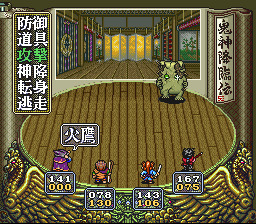
When she was still alive, she gave birth to a child, but died soon after and turned into a demon. The baby was entrusted to a sleazeball, who sent the child to live in poverty. The woman this youkai cursed was her sister, jealous of the happy life that was denied to her. Soon after, the youkai’s long-lost daughter is revealed to be Akoya, one of our protagonists, and the story ends on a happy note once mother and daughter are briefly reunited. Thankfully!
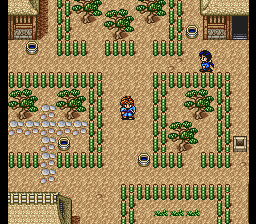
For a Super Famicom game that was released when it was, the characterization of your party members is superb. There’s a great chemistry present throughout the story: they bicker, they tease each other, and everyone always has a strong opinion on whatever youkai-related shenanigans occurring at that particular moment, and it’s done in a way that doesn’t feel forced or tiresome to read through, especially compared to say, a Tales Of...title.
There’s a strong theme of “found family” in Kishin. Hokutomaru is adopted into the Minamoto family after being orphaned as a child; Akoya receives an offer to join the family she saves after it is revealed that she is their blood, but rejects them in favor of the children living in the slums of her home city who she feels a deep sense of responsibility for.. Hourin, a middle-aged monk who joins your team early in the game, gives up a life of drunken laziness in order to save a little girl who looks up to him. As someone who isn’t close with his blood family, I know how important a found one can be, so the game made me quite emotional at points, so while the main plot isn’t anything special, the characterization is incredibly strong.

The battle system is, again, fairly standard, but it does a few things worth noting: once you acquire certain weapons, each character is able to transform into an oni: giving up the ability to cast magic spells in exchange for increased physical damage. The design of each oni is wonderfully gaudy and colorful, and as there are monsters who are vulnerable to oni and not much else, you’ll have plenty of opportunity to use them. While switching between forms costs you a turn, you can choose to begin battle in either monster or human status by changing an option in the settings menu. Convenient!
Characters do not learn magic by leveling up, but instead learn abilities from various gods that you meet throughout Japan. They’re all based on traditional mythology, and you’ll need to complete side-quests to receive their aid. Some of them are entirely missable, so I strongly recommend using a guide. I accidentally locked myself out of a few just in this playthrough, which is a major bummer!
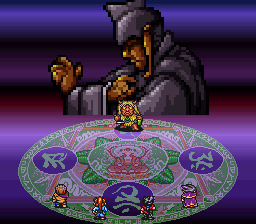
Furthermore, side-quests seem to open up at random - the game provides very few hints as to what is out there, so unless you’re following a guide, you’ll have to visit each area multiples times after each major plot point in order to collect them all. Wack. That said, it is really fun once you discover something unexpected: you’re often given a choice or two, so make sure you save very often! The game has major issues with balance: at certain points of the game, you’re going to have to grind. A lot. Like, at least for 2 hours or so. Early on in the game, you’ll be locked into a dungeon with no save-point, so you’re utterly screwed if you don’t bother to level up. The game provides a recover point, but there was no warning that you wouldn’t be able to leave the area until you clear it. I wound up grinding for around an hour and a half, in one long session. Decidedly unfun.

On top of the unbalanced pacing, the encounter rate in this game is absolutely wretched, even for its time. I am a massive fan of RPGs from this era. I imagine I have way more love for them than most people. But Kishin really, really tries my patience at points. You’ll finish a battle, and get into another one three steps later. It’s BAD. This wouldn’t be so terrible if the combat system flowed a bit quicker, but they don’t. The game occasionally likes to throw you into successive dungeons with no stopping point, and these sections feel especially draining. Despite these complaints, I really am enjoying my time with Kishin. Judging from the guide I have been using, I am around 3/4ths of the way through the game, and I intend on clearing it. If you have a lot of patience and love of the genre, I strongly recommend it! There’s several more games that were released after this one, and I look forward to trying them all.
#jrpg#video games#game review#gaymer#this needs editing but im tired of looking at it#sorry lovs#samurai#historical games#oni series
2 notes
·
View notes
Text
#6: Updates.
I’ve gained a few followers! That makes me really happy - I put an embarrassingly long time into making each post, so thank you! My current plan is to only update once a week or so. I’m currently working on a review for Romancing SaGa 1, and it’s taking me way longer than I anticipated. I have so much love for the game, and trying to edit my thoughts into something that is readable has been a challenge! In the meantime, I started a new game that I know absolutely nothing about. Check out the totally wicked title screen below.

0 notes
Text
#5: 遙かなる時空の中で ~八葉抄~
I'm obsessed. After how much I enjoyed Neo Angelique Special, I was so excited to see that their developer, Ruby Party, had several more series to explore. The last Ruby Party game I played was set in Arcadia, a well developed, yet somewhat generic fantasy world. While that was fun in its own way, Harukanaru drew my attention because of its unique setting: Heian Japan.

I have always been obsessed with this era of Japanese history. It was a time of unprecedented artistic creation, political sabotage, and wealth. The era produced incredible works of literature, such as The Genji Monogatari and The Pillow Book. Poetry was no exception, as this was the era of Ono no Komachi and Izumi Shikibu.
The main plot of the game (as of this writing, I have yet to complete it!) is fairly standard stuff: you play as a young high school student who is mysteriously transported to the world of Kyo, and soon discovers that she has a special power that the people of the land need in order to prevent a disaster. There’s been a few interesting twists here and there, but nothing I haven’t seen before.

The characters are what make this game shine - I’m not exaggerating when I saw that this might be my favorite cast. In any game. Ever. Their designs are immaculate and reflect their personalities extremely well. Take a look at the image above: the man on the left is named Minamoto Yorihisa. He has his hair up, his posture is stuff and his clothes are worn tight to the body. You can immediately tell that he’s a warrior. He is serious. He is sworn to his duty to protect his charge.
In contrast, Tachibana Tomomasa gives off the opposite impression. His clothes are loose and hang about him, he wears his hair down, and his demeanor and pose just scream, “I don’t really care. I’m also lazy.” And this is exactly how he is! I love games that take special care to not only show, but also tell. Each and every character is designed this way, and it really makes the whole cast sparkle.

One of my complaints about Angelique Special was that the battle sequences were far too easy: you rarely had to use healing spells, and the buff and debuffing abilities were essentially useless. There was only one battle near the very end that posed any sort of challenge, and it was entirely optional! It made the whole process feel pointless, and sometimes felt like a cheap way to lengthen each run through the game. Harukanaru is different. While the overall difficulty is still rather low, I still experienced way more tension than I ever did in Angelique Special. Certain enemies have nasty AOE attacks, can seal your special abilities, and so forth. As far as I can tell, there are no group healing spells, so having to rely on single-use items you acquire through mini-games made the whole experience a lot more engaging.
Speaking of which, I love the enemy design! Many, if not all, of the enemies are based on Japanese mythology, and there’s a huge variety present. Later on in the game, you’re able to seal them away into cards, which can be equipped to your characters in order to boost their abilities, as there is no level-up system present.

Besides enemy cards, there are lot of fun things to collect throughout each run, such as flowers, writing papers, and incense. You can use these to write letters to your favorite character, and each one naturally has their preferences as to what they like. You acquire these by playing a simple game of memory, which I am absolutely TERRIBLE at, so I just abused save states until I got whatever I wanted. I’m lazy! Overall, Harukanaru is a complete delight, especially for fans of Heian-era culture and history. As I get closer to the ending, I can’t wait to see just who my MC ends up with, and I look forward to collecting all the endings the game has to offer. The writing is fantastic, the plot is well-paced, and the variety of things to do in between plot points has kept me engaged and immersed. As Harukanaru is a very long-running series, with around 6 titles as of the time of this writing, I very much look forward to exploring the rest of the games. I’m a fan!
7 notes
·
View notes
Text
#4: Neo Angelique
I’m weak. I should have kept trying, but Devil Summoner has beaten me. I’m going to have to restart on the Normal difficulty. My pride as a gamer lead me to believe I could beat a Megaten game for the first time on the highest difficulty. I am ashamed.
So, I decided to replay a game that has become very dear to me. While my main genre is RPGs, I played quite a bit of Neo Angelique on a complete whim around a year ago. Neo Angelique is a very important game to me, as it came into my life when I was going through an incredibly messy break-up. On top of that, I was facing issues with housing and employment. I literally didn’t know if I would have a house or job at the end of it all. I was despondent.


Neo Angelique was my escape. You play as an ordinary young woman, studying at a university to become a doctor. She’s kind, but assertive when she has to be, and when her true identity becomes clear, the fate of the entire universe rests on her shoulders. The game is immersive, with a massive amount of lore that you’ll naturally discover as you play. I found myself really caring about the world of Arcadia, and it was a perfect escape from the roaring dumpster fire that was my personal life.
It’s also a game very much focused on romance: each of the four main characters has their own route, and going through each one changes the story, and subsequent ending, by a significant amount. Each playthrough also offers new information about Arcadia, and this naturally lead me to complete the game multiples times. Two secret routes also exist, but given that I’ve logged 60 hours into the game, and STILL haven’t completed every normal route, that says something. This game is packed!

There’s some dark plot points for the drama, but in the end, everything ends up okay. You and your chosen beau (or not!) end up just where they need to be. I really needed that back then. I still need it now. Sometimes, you need an assurance that things will be okay. It’s a fairy-tale disguised as a game.
Neo Angelique did that for me. The world isn’t always nice. It isn’t always fair. Sometimes, life will punch you in the face, and the best you can do is hope it doesn’t shatter your nose.

I’m so grateful for this otome game. Thank you, Ruby Party. You’ve done me a solid.
#otome games#otome game#neo angelique special#angelique special#visual novels#angelique series#gaymer#ruby party
5 notes
·
View notes